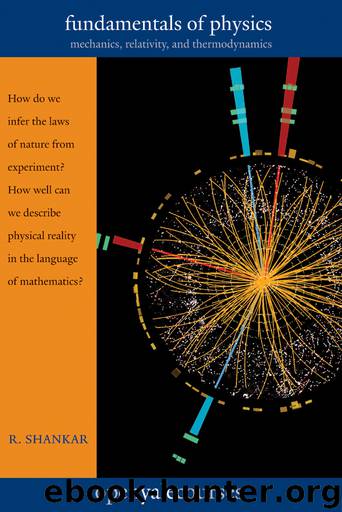Fundamentals of Physics by R. Shankar

Author:R. Shankar [R. Shankar]
Language: eng
Format: epub
Publisher: Yale University Press
Published: 2013-03-03T16:00:00+00:00
At t″ = 0, the whole rod is straight, while at t″ = uL0/c2, even the left end has begun falling.
In your frame, the right edge of the hole moves leftward at speed u, and it is always at z′ = 0. Since it was to the right of the right end of the rod to begin with, it will never overtake the drop-point, which moves leftward at a speed . Since > c, by the time the right edge of the hole crosses any point on the rod, that point will have already fallen below z′ = 0. (That > c does not imply interactions or signals propagating at superluminal velocities. The points that make up the rod fall independently of each other and do not interact with each other in our treatment.)
If this discussion leads you to conclude that the notion of a rigid body does not exist in relativity, you are correct.
In summary, you and I can accuse each other of using shortened rods, and we can both be right. This is because the operational way to find the length of a moving body involves measuring the two ends simultaneously, and simultaneity is relative: you will say you measured the two ends of my rod at the same time and I will disagree, and vice versa.
Download
This site does not store any files on its server. We only index and link to content provided by other sites. Please contact the content providers to delete copyright contents if any and email us, we'll remove relevant links or contents immediately.
| Fluid Dynamics | Thermodynamics |
The Complete Stick Figure Physics Tutorials by Allen Sarah(7307)
Secrets of Antigravity Propulsion: Tesla, UFOs, and Classified Aerospace Technology by Ph.D. Paul A. Laviolette(5309)
Thing Explainer by Randall Munroe(3877)
The River of Consciousness by Oliver Sacks(3538)
The Order of Time by Carlo Rovelli(3145)
How To by Randall Munroe(3033)
A Brief History of Time by Stephen Hawking(2960)
I Live in the Future & Here's How It Works by Nick Bilton(2935)
The Great Unknown by Marcus du Sautoy(2646)
What If?: Serious Scientific Answers to Absurd Hypothetical Questions by Randall Munroe(2637)
Midnight in Chernobyl by Adam Higginbotham(2483)
Blockchain: Ultimate Step By Step Guide To Understanding Blockchain Technology, Bitcoin Creation, and the future of Money (Novice to Expert) by Keizer Söze(2445)
Networks: An Introduction by Newman Mark(2360)
The Meaning of it All by Richard Feynman(2300)
Easy Electronics by Charles Platt(2281)
The Tao of Physics by Fritjof Capra(2229)
Midnight in Chernobyl: The Untold Story of the World's Greatest Nuclear Disaster by Adam Higginbotham(2177)
When by Daniel H Pink(2082)
Introducing Relativity by Bruce Bassett(2076)
